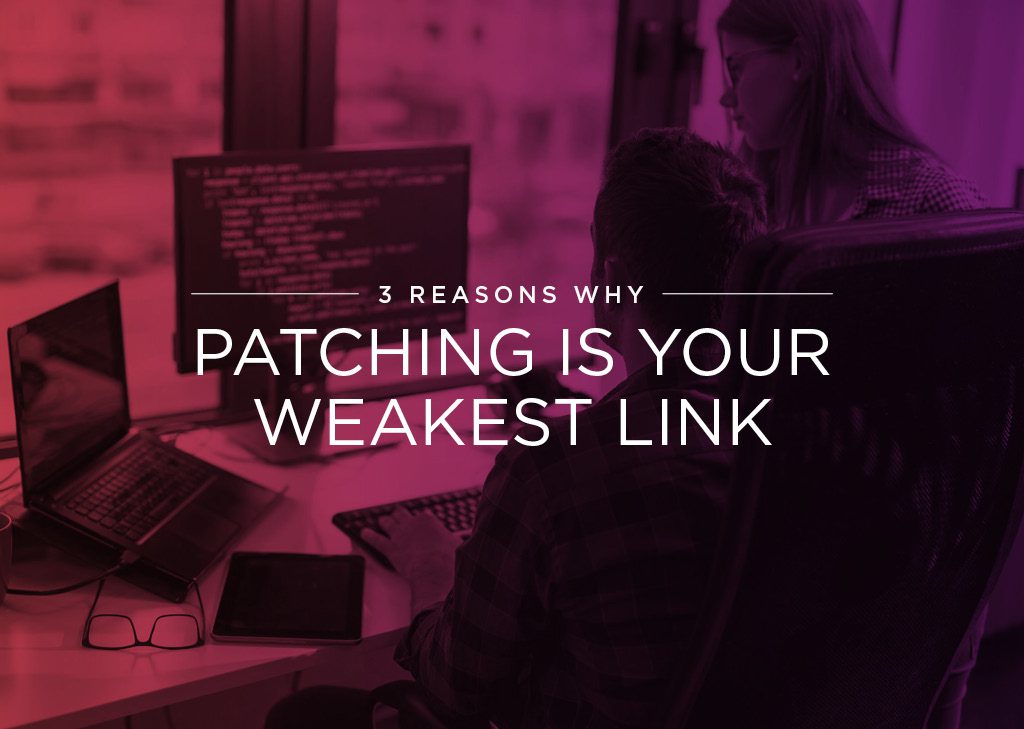
3 Reasons Why Patching is the Weakest Link in Organizational Security
What’s the weakest link in your organization?
It’s been said many times that people are the weakest link in the security arsenal. Phishing scams enjoy success primarily due to the gullibility or inattention of people. All it takes is one clueless employee clicking on a malicious link or attachment and the entire network can be compromised.
But whether it is a virtual environment like a computer network or a physical environment like defending a castle, people have always been the weak link. In the old days, all it took was one person selling out to the enemy for a few coins. Later that night, the gate is left unlocked and the portcullis isn’t dropped.
Therefore, let’s take people out of the discussion, recognizing that there will always be a human element to address. What, then, is the weakest link among the many components of the organizational security arsenal? A strong argument could be put forward that patching is the clear winner. Here are three reasons why.
1. Vital Patches Don’t Get Deployed
Think about some of the recent breaches impacting the enterprise such as Microsoft Exchange Server, Adobe Flash Player, the Fortinet VPN, and VMware vSphere. Serious security holes were discovered. Urgent patches were issued, news stories abounded about the need to deploy these patches at once, otherwise ransomware and other cyber-scourges lurked.
Yet systems are still being discovered almost five months later that have yet to shore up their Exchange Servers. The FBI even got in on the act, breaking into corporate systems to remove malware. To make matters worse, critical security patches from May of 2019 such as those fixing the Fortinet VPN hole have been found undeployed.
2. The Bad Guys Search Out Unpatched Systems
Yes, there are a few criminal hacking geniuses out there who devise new and ingenious ways of breaking into systems or who can find a hole no one else ever spotted. But that accounts for a minuscule number of actual hacks. Almost all take advantage of known security issues, most of them having patches readily available.
Talk about making it easy for the criminal! The bad guys scan for instances of obsolete OSes, or insecure applications. Where they find Windows XP, Windows 7, Internet Explorer, or Adobe Flash Player, for example, they rub their hands in glee. Similarly, they search around for systems that haven’t deployed patches such as Exchange, VMware, or Fortinet. When they find one, they know they are onto a sure thing. From that point, they can infiltrate confidential data or initiative a ransomware attack.
3. Manual Patching Leads to Backlogs
Many organizations still take care of patching manually. They evaluate each patch and determine if and when it is to be installed. This inevitably leads to errors, delays, and heightened risk.
Another area where manual processes tend to bog down patch deployment is testing. Organizations want to verify that a patch won’t break other systems. They establish procedures to test patches before deployment. Unfortunately, many patches stack up in backlogs. Urgent patches go undeployed while someone in IT tests low-priority patches to verify their integrity.
How Syxsense Can Help
Syxsense eliminates the many reasons why patches don’t get deployed. It lets you easily manage unpatched vulnerabilities with the click of a button. It includes patch supersedence, patch roll back, and a wealth of automation features.
In addition, it provides a three-hour turnaround for the testing and delivery of new patches as well as technology to send software and patches across the wire once, using peer-to-peer within the network for local distribution. Don’t tempt fate by relying on manual patching processes.
Start Your Free Trial of Syxsense
Syxsense combines IT management, patch management, and security vulnerability scanning in one powerful solution. Get started today.







